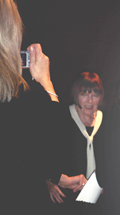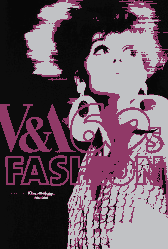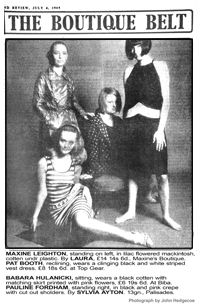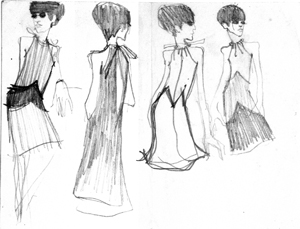Previous events: Jan 2007
Reconstructing Sixties Fashion
Report by Judy Tregidden & Lindsay Evans Robertson
The Costume Society presents a programme of events throughout the year in addition
to the annual Symposium. These events involve large and small museums and the study
of specific aspects of dress. Such events may be in conjunction with some of the
nine regional costume and textile societies in the UK or with major exhibitions.
Reconstructing 60s Fashion was a study day held on Saturday 20th January 2007 in
association with the Victoria and Albert Museum. It was organised by Sylvia Ayton,
Vice-Chairman of the Costume Society, and Jenny Lister, Curator of Fashion and Textiles
(1800 - 1914) in the V & A’s department of Furniture, Fashion and Textiles and co-curator
of the 60s Fashion show.
In the 1960s London became the centre for young fashion,
spearheaded by a group of very young designers all determined to create fashion
for their contemporaries that was nothing like the clothes that their parents and
grandparents were wearing. Their success grabbed the imagination of youngsters,
male and female, world wide. Fashion, accessories, make-up, hairdressing, styling
and journalism, all changed in response to their creativity. It was a relatively
small band of “movers and shakers” but their collective success has repercussions
even in 2007. In retrospect it was a reaction to the dismal war years and the restrictions
of the 50s, but it seemed so much more.

Imagine - all the legendary names that made London the Swinging capital of the fashion
world, all in one room together! Thanks to the teamwork, tact and diplomacy of Sylvia
Ayton and Jenny Lister it happened, not in the 1960s but in January 2007. This was
a reality show to savour and remember.
So many famous names were there. Mary Quant,
Barbara Hulanicki, Marit Allen, Bernard Neville, Paul Reeves, Moya Bowler, Felicity
Green, Beatrix Miller, Vanessa Denza, Christopher Carr-Jones, Justin de Villeneuve,
Brigid Keenan, Marion Foale, Sally Tuffin, Sylvia Ayton, James Wedge, David Montgomery:
the roll-call was endless. To list every name would cause offence to the name that
is inadvertently left out; it was exciting to meet these people once again and find
that all were as alive to today’s fashion, art and design as they ever were. The
audience was intriguing. Serious students of fashion and their lecturers had a field
day hence the total sell-out of tickets. There were many young students at the event
dressed in 60s vintage garments, or were they perhaps wearing new retro? High street
fashion is so influenced by the 1960s, it is hard to tell. People for whom the 60s
was a part of their growing up shared memories of what fun it had been, a phrase
echoed again and again by the speakers. Alumni of the Royal College of Art from
the 60s, and of many other fashion courses, met up again and found so many of their
contemporaries as passionate about fashion design as ever.

The day was presented through interviews, slide shows, videos, illustrated talks
and academic overviews giving a scintillating picture of the period: a triumph of
organisation appreciated as such by Valerie Cumming, our Chairman, as she closed
the day.
The event was opened by Christopher Breward (Deputy Head of Research at
the Victoria and Albert Museum and Professional Fellow at the London College of
Fashion) who introduced Sylvia Ayton, ex-Wallis designer and still very involved
with fashion education. Sylvia gave us a resume of her multi-faceted career as a
designer and examiner and lecturer in education.

She spoke of her early years at art school as a couture-worshipping student gradually coming
to realise that clothes designed for young people, for working class people, hardly existed
and that couture was a mirage that needed to be made a part of the high-street: as outer-wear
designer for Wallis Sylvia succeeded in doing so. She reminded us of how important the Fashion
School of the Royal College of Art in particular and the art schools were as hot-houses in
the 60s for this new wave of energy and ideas: Sylvia’s fellow students included Marion Foale,
Sally Tuffin and James Wedge, all of whom played a significant part in the 60s fashion revolution.
Vanessa Denza, of Denza International, introduced Marion Foale and Sally Tuffin. Vanessa has
been a considerable influence in the retail world. She was the original buyer for the innovative
21 Shop at Woollands in Knightsbridge in the 60s, became the founder of Graduate Fashion Week
in the late 80s and received her MBE in 2004 for her services to the British fashion industry
and education. Many of the young designers of the 60s owe a great deal to Vanessa. Sally and
Marion were amongst those young designers and shared with delight their memories as they talked
of their success in the 60s and how simple it was, then but not now, to get their careers
started; how easy it was to open a shop in Carnaby Street, how amazing to be flying around
America feted wherever they went.
Journalism
and photography was elegantly put in context by academic Alice Beard (Kingston University)
who then chaired a conversation between Marit Allen (Queen and Vogue and now working
as a costume designer for films) and Sandy Boler (English Vogue). Their reminiscences
of 50s fashion journalism overshadowed by couture and class, and how they had helped
to change that, was made to seem so logical. In truth, it was anything but easy.
Felicity Green, then working on the Daily Mirror, presented another facet of journalism,
that of the daily press which presented challenging deadlines that needed immediate
response. It required news headlines, daily, and the ability to spot talent and
trends which her readers could identify with. It inspired a new breed of photographers
who wanted narrative, real locations, jumping skipping models who could identify
with the 60s chick. Felicity’s achievement was to shine in this milieu. Her attitude
and her positive response to an angst-for-the-past questioner was to affirm her
own love of now and the future: to long for the past is to die - to look to the
future is to live was her reply.
During the day so many “iconic” images were presented
but none with more style and wit than Justin de Villeneuve, one-time boxer, hairdresser,
manager, photographer and self-confessed villain. So many of those famous images
of the period were his, demonstrating how good he had always been at shooting ‘dolly
birds’. But his real fashion-show stopper proved to be his latest shots of birds-for-real
giving us their own fashion show, glamour models, hoods and gangsters, as a glorious
conclusion.
Drawing roughs of original black dress in newspaper
clipping above: by Sylvia Ayton

Boutiques and shops were introduced by Sonia Ashmore (Research Fellow at the London
College of Fashion) who had the privilege of introducing the revered Mary Quant
who gave us a gentle overview of her career, its complexities and her ground-breaking
diversification which paved the way for so many other designers. Amongst many well-known
images Mary Quant, with touching pride, presented her favourite ‘product’ of the
60s, her baby son. Then Oriole Cullen (Curator, Modern Textiles and Fashion, Victoria
and Albert Museum) interviewed the equally revered Barbara Hulanicki, taking so
many of the audience down memory lane. Barbara reminisced: it had all been such
fun, despite the traumas of business but Barbara, too, emphasised that what was
possible then in a period of hope, creativity and a brave new post-war world, is
no longer possible. Trading and industry has changed so much in the intervening
years that the naïve entrepreneurial spirit of that time could not survive the pressures
of the industry in this twentieth century. An audience member’s delightful tribute
to Barbara Hulanicki thanking her for making us all look so beautiful in those platform
boots and dresses closed the session perfectly.
Music and menswear, of course, were
an important part of that 60s scene. David Gilbert (Reader in Human Geography, Royal
Holloway, University of London) introduced Music and ‘The Scene’ and Paul Gorman
(author) who spoke of how it had developed. Then he and Paul Reeves, menswear designer
in the 60s, discussed The Look, Adventures in Rock and Pop Fashion. Paul Reeves
took great delight in his reminiscences of the period especially of his men’s wear
label Sam Pig in Love.
It was an unrepeatable event which truly reconstructed 60s
fashion. We are proud that the Costume Society played a part in its presentation,
cementing our long association with the Textiles and Dress Department of the Museum.
How sad though, that very day, to read in the press of the demise of the Jean Muir
label, yet another name which played an important part in the 60s. But how exciting
to read Sarah Mower’s very generous coverage of the event, Reconstructing 60s Fashion,
featured in the Daily Telegraph on Wednesday, 24 January. That was a bonus we had
not expected: the Society is very grateful.